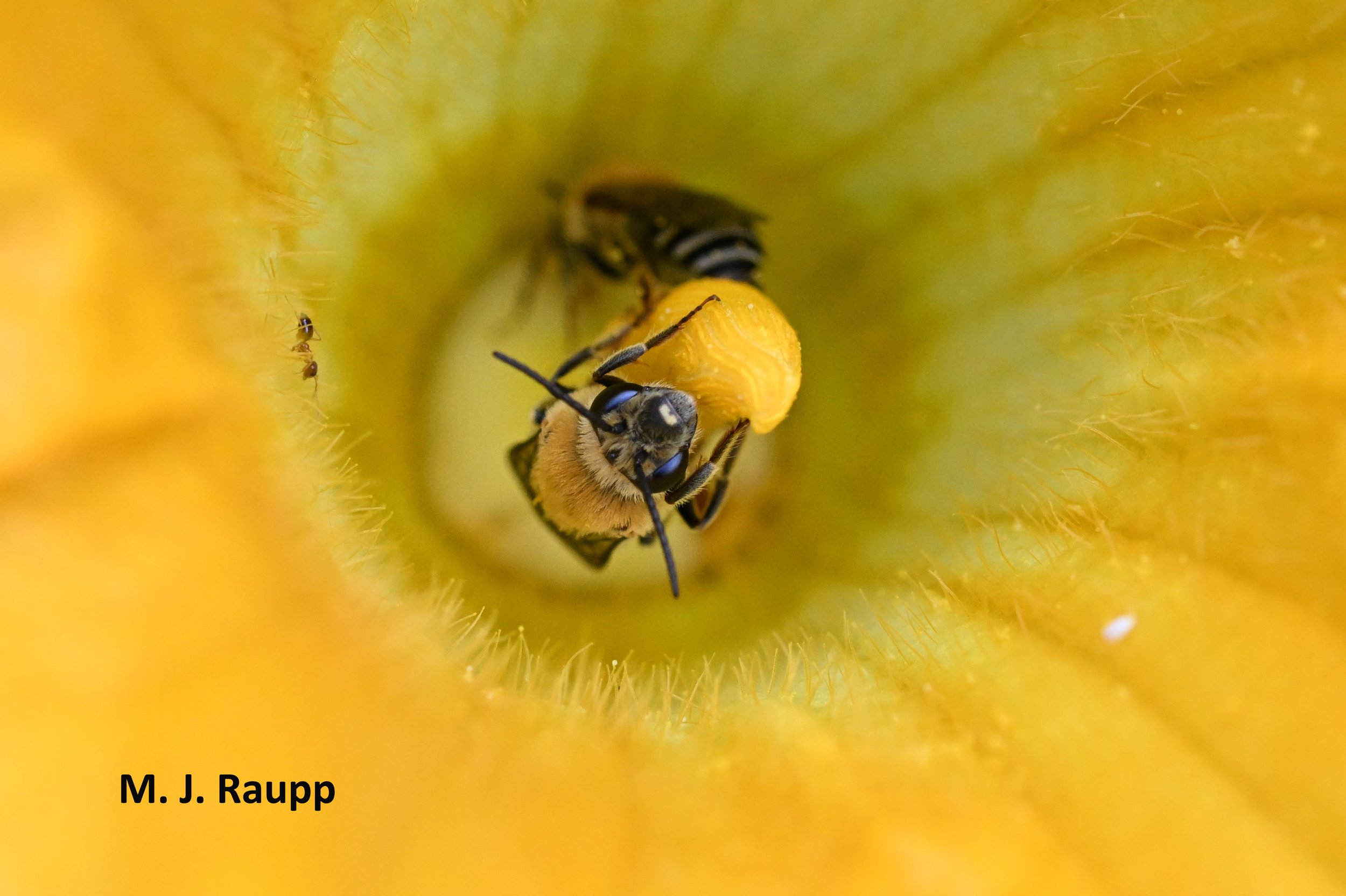Why give thanks to the bees? Here’s why. According to the US Fish and Wildlife Service some 4,000 species of native wild bees pollinate a vast assortment of agricultural crops in the United States, including several of those we will find on our Thanksgiving table. Bees are key providers of pollination services to agricultural crops. Estimates of this value in North America and the US range from 15 to 34 billion dollars annually. Worldwide, the United Nation estimates the worth of pollinators to global food production ranges between 235 to 577 billion dollars annually. Although they are not native to the US, our hard-working honey bees contribute 5.4 billion dollars annually to our agriculture and in 2023 honey bees produced some 139 million pounds of honey valued at $2.52 per pound. While these figures are mind-boggling, one easy way to wrap your head around the benefit of pollinators is this: every third bite of food you take is brought to you by a pollinator.
For many of us this week, Thanksgiving provides a memorable feast with family and friends. While the iconic turkey and fixings are fine, my personal favorite of the Thanksgiving feast is dessert, where tasty pies take center stage. Who doesn’t like pie to top off a turkey coma? So, let’s take a quick “tour de pie” to learn why we need to celebrate and give thanks to bees on this Thanksgiving Day.
Cherry pie – Blue orchard mason bees
The first days of spring herald blue orchard mason bees. These early risers emerge in March and April to pollinate cherry trees, the fruit for our cherry pies.
Just in time to pollinate cherry trees, blue orchard mason bees emerge in early spring ensuring lots of cherries for cherry pies.
Apple pie – Rufus-backed cellophane bees
Here in the DMV in April and May cellophane bees emerge, tussle a bit, and then fly off to pollinate a variety of plants including apple trees. Apple sauce, apple dumplings, apple pie.
Super cute ground nesting bees like this cellophane bee emerge when apple trees are in bloom. They help bring fruit fillings for tasty apple pies.
Pumpkin pies – Eastern cucurbit bee
What would Thanksgiving be without pumpkin pie, brought to us by amazingly cute cucurbit bees, a.k.a. squash bees?
Squash bees specialize in pollinating members of the cucumber family including jolly sugar pumpkins perfect for pumpkin pie.
Blueberry pie – Perplexing bumble bee
Beautiful perplexing bumble bees buzz-pollinate a wide variety of native plants and crops, including blueberries. As an added Thanksgiving treat, bumble bees pollinate the cranberries that garnish your turkey.
In addition to pollinating scores of native plants, bumble bees like this pretty perplexing bumble bee, buzz-pollinate tasty treats like blueberries for pies and cranberries for yummy cranberry sauce.
Honey bees – Apis mellifera
Hardworking honey bees pollinate plants that provide fruit for pie filling in addition to pollinating other vegetables and beautiful bouquets gracing our Thanksgiving table.
Unfortunately, all is not well in the realm of bees. A recent report on pollinators found that 34.7% of bees in North America are at an elevated risk of extinction with solitary species at the greatest risk. The root causes of these threats varied among different regions of the continent. In western and northern regions, climate change created the greatest risks to bees. In addition to climate change, agriculture presented an additional threat to bees in the Rocky Mountains and Great Plains. In the eastern United States including the DMV, pollution, housing and urban development, as well as agriculture were the biggest threats to bees. What about our iconic honey bees? Well, between June 2024 and March 2025 commercial beekeepers experienced catastrophic colony declines with 62% of their colonies lost, the largest losses ever recorded . Even hobbyist beekeepers felt the sting with a loss of 51% of their colonies.
Let’s be thankful for bees at our Thanksgiving dinner. Little ones like the early-rising blue orchard mason bee as she puts the finishing touches on a brood chamber that might be full of apple pollen ensuring apples for apple pies this Thanksgiving. Next, a female rufus-backed cellophane bee tussles with some male suitors before flying off just in time to pollinate a cherry tree. Any time of year cherry pie is a favorite. In addition to squash, my squash bees pollinate pumpkins for Jack O’ Lanterns and, yes, pumpkin pies. Perplexing bumble bees pollinate a wide variety of crops and flowering plants. When not pollinating teasel, they may be working on blueberries for blueberry pie or cranberries for the cranberry sauce at the Thanksgiving feast. Hardworking honey bees pollinate plants that provide fruit for filling pies, vegetables gracing our Thanksgiving table, and hundreds of other agricultural crops and flowering plants. So, let’s give thanks to our amazing bees on this Thanksgiving Day.
There are things all of us can do to show our gratitude to bees. To learn more about ways to help save our bees and the services they provide, please visit the Bee Conservancy’s website “10 Ways to Save the Bees…”. Also, David Goulson’s remarkable book “Silent Earth: Averting the Insect Apocalypse” helps us understand the plight of bees and all insects and is replete with actions that governments and individuals can take to help preserve insects and the natural world.
On this Thanksgiving Day, as we eat our pumpkin or apple pies, let’s take a moment to give a little thanks to the industrious cadre of tiny, winged creatures that help bring us our meals and help the natural world keep on turning, the bees.
Acknowledgements
Bug of the Week thanks Margarita López-Uribe whose fascinating studies of squash bees inspired this episode. The important reference “Elevated extinction risk in over one-fifth of native North American pollinators” by Tara Cornelisse, David W. Inouye, Rebecca E. Irwin, and Bruce E. Young, and “Silent World” by David Goulson were consulted to prepare this episode.



